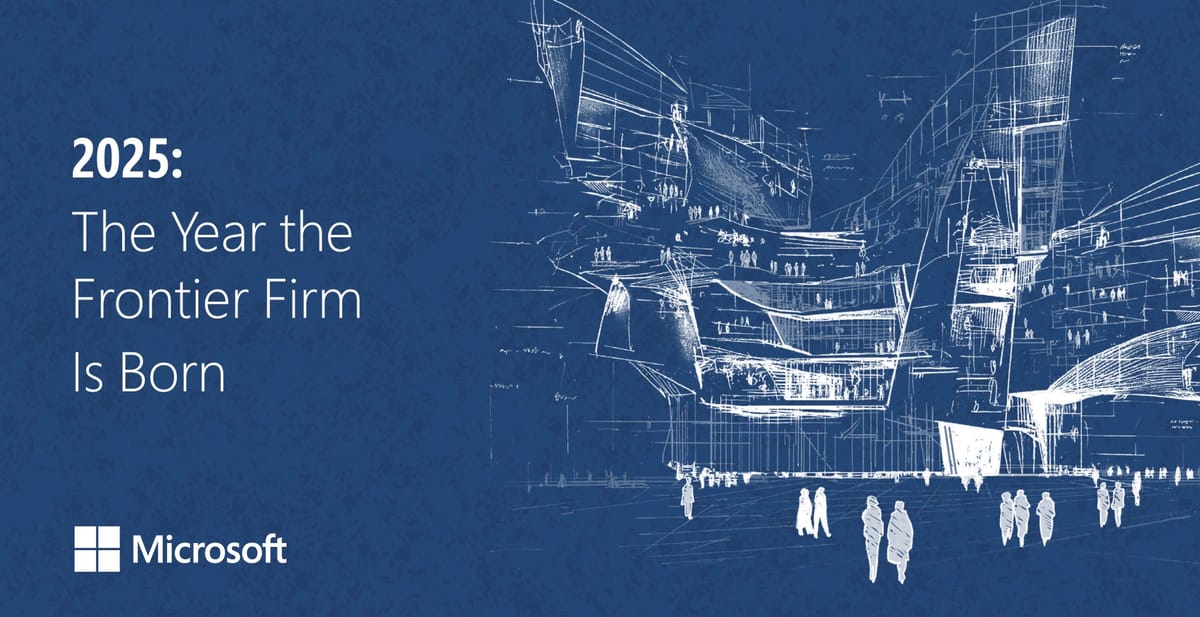
Microsoft's latest Work Trend Index Annual Report presents a compelling vision of what's next in our evolutionary dance with artificial intelligence. The report outlines how we're moving beyond the early adopter phase toward a new organizational structure built around "intelligence on tap" and human-agent teams.
Having tracked the progression of AI in business for several years now, what strikes me most about this report isn't just the data – though those numbers tell a fascinating story – but rather how it captures the acceleration of a broader paradigm shift in how we organize for productivity and innovation.
2025 isn’t the year AI changes work. It’s the year work gets redefined.
When Microsoft calls 2025 “The Year the Frontier Firm Is Born,” they aren’t just launching another corporate slogan. They’re making a claim about a structural inflection point—similar to how cloud computing redefined infrastructure or mobile reshaped the interface layer. Except this time, the shift isn’t about where computing happens. It’s about who does the work.
Welcome to the age of digital labor. Let's dive into their findings.
From Scarcity to Abundance: The Intelligence Resource
The core insight that rings truest in Microsoft's analysis is how intelligence itself is transitioning from a scarce to an abundant resource. For decades, specialized human knowledge represented one of the most valuable and limited assets in business, bound by both human capacity and cost constraints. The report frames this shift elegantly: "Intelligence is becoming an essential durable good: abundant, affordable, and available on demand."
This transition creates what economists would call a classic supply shock – when a previously constrained input suddenly becomes abundant, entire industries restructure. The most striking statistic supporting this: 82% of leaders expect to leverage agents as digital team members within 12-18 months.
Why now? The data points to a widening "capacity gap" that's become unsustainable: 53% of leaders say productivity must increase, yet 80% of the global workforce reports lacking sufficient time or energy for their work. With employees interrupted every two minutes during core work hours (averaging 275 interruptions daily) and meetings after 8 p.m. up 16% year-over-year, we've stretched human cognitive capacity to its breaking point.
The Aggregation of Intelligence
Much like how the internet enabled the aggregation of demand (platforms), supply (marketplaces), and information (social networks), AI enables the aggregation of intelligence itself.
Before, intelligence was locked in human minds and organizational processes, necessarily fragmented and siloed. Now, it can be pooled, scaled, and deployed on demand. The Microsoft report indicates 24% of companies have already deployed AI organization-wide (not merely in pilots), suggesting we're moving from experimentation to systematic implementation.
This aggregation follows a three-phase evolution outlined in the report:
- Human with assistant: AI removes drudgery, helping people work faster
- Human-agent teams: AI takes on specific tasks at human direction
- Human-led, agent-operated: Humans set direction while agents execute entire workflows
That’s why early adopters—what Microsoft calls “Frontier Firms”—are surging ahead. These organizations are already integrating agents into workflows. The results are telling: higher productivity, faster scaling, and more meaningful work. One founder runs a $2M staffing firm solo, thanks to AI. Another firm ditched its CFO role entirely, using a single tool to manage forecasting.
The New Org Chart is a Work Chart
Perhaps the most profound implication of this shift is how it upends traditional organizational structures. The traditional org chart, built around functional expertise siloed in departments, gives way to what Microsoft calls the "Work Chart" – a dynamic, outcome-driven model where teams form around goals rather than functions.
This mirrors the transition to agile methodologies we saw in software development, but at an organizational scale and accelerated by AI. Just as DevOps broke down walls between development and operations, AI is breaking down walls between traditionally separate domains like marketing, data science, and product development.
The report cites a Harvard study showing how AI helped break down silos, with R&D teams producing more commercially viable work while business teams developed more technical solutions. This blurring of traditional skill boundaries suggests we're moving toward teams defined by outcomes rather than inputs.
One quote particularly captures this shift: "Working with agents is like onboarding a new team member—you don't micromanage, but you need informed trust." This signals a fundamental change in how we think about delegation and oversight.
The Human-Agent Ratio: The New Corporate Metric
Every technological revolution brings new metrics that define business success. The industrial revolution brought output per labor hour. The digital revolution brought user engagement metrics. The AI revolution appears to be bringing us the "human-agent ratio."
So how should leaders approach this shift strategically?
It’s tempting to think: more agents, fewer humans, better margins. But Microsoft’s research tells a more nuanced story. Too few agents, and you leave productivity on the table. Too many, and you overwhelm your human managers, risking burnout and business error .
This ratio will vary dramatically by function – customer service, marketing, and product development are cited as the top three areas for accelerated AI investment. Functions far from a company's competitive edge will likely see higher agent-to-human ratios, while those central to value creation may maintain lower ratios with greater human involvement.
Importantly, the point isn’t to replace workers—it’s to elevate them.
The Real Risk: A Two-Speed Workforce
Perhaps most concerning in Microsoft's findings is the emerging gap between leaders and employees in AI adoption and mindset. While 67% of leaders are familiar with agents, only 40% of employees say the same. Leaders are more likely to see AI as a career accelerator (79% vs 67%), use AI as a thought partner, and expect to manage agents in the coming years.
This suggests a potential new digital divide forming not between organizations but within them – between those who develop an "agent boss mindset" and those who don't. The risk here is a widening power gap where leader-level employees leverage AI as an exponential force multiplier while front-line workers struggle to adapt.
Interestingly, today's leading indicators show AI adoption is happening differently than previous waves of digital transformation. While earlier technologies often saw bottom-up adoption with employees bringing consumer tools into the workplace, AI adoption appears to be following a more top-down pattern. This likely reflects both the complexity and strategic importance leaders place on getting AI implementation right.
Fixing this isn’t just about software access. It’s about building new habits, workflows, and, above all, mindsets. Every employee must become an agent boss. That means knowing how to delegate, how to prompt, how to edit AI outputs, and when to override bad logic.
AI is a cultural transformation, not just a tech rollout.
Structuring for Success: Platforms, Aggregators, and Frontier Firms
If we apply the theory of aggregation to the corporate landscape, we can anticipate how value will accrue. Just as internet-era aggregators captured disproportionate value by controlling access to users, AI-era "intelligence aggregators" will likely capture outsized value by controlling access to intelligence resources and the models for deploying them effectively.
Microsoft's data shows that early Frontier Firms are already demonstrating this advantage:
- 71% report their company is thriving (vs 37% globally)
- 55% can take on more work (vs 20% globally)
- 90% report meaningful work opportunities (vs 73% globally)
- 93% are optimistic about future work prospects (vs 77% globally)
These aren't minor differences – they're step changes in organizational performance that suggest Frontier Firms may enjoy significant competitive advantages. The examples cited in the report are telling: Dow saving millions in logistics with an agent system, Wells Fargo cutting query response times from 10 minutes to 30 seconds, Bayer researchers each saving 6 hours weekly.
What This Means for You
Here’s what this means depending on your role:
- Startups: Build around agents from day one. Don’t hire for repetitive tasks—hire for judgment and strategic oversight.
- Enterprises: AI isn’t a feature. It’s an operating model. Don’t treat this like a toolset upgrade—treat it like a full-stack redesign.
- Employees: Your career trajectory now hinges on how well you manage and collaborate with digital labor.
The real insight isn’t that AI is replacing people. It’s that jobs are becoming more abstract. The most valuable employees won’t be the ones who do the work—but the ones who know how to scale it.
The Path Forward: Three Strategic Imperatives
For organizations looking to position themselves as Frontier Firms, Microsoft's report suggests three strategic imperatives:
- Hire your first digital employees: Define clear roles for automation and treat agents like team members with onboarding, responsibilities, and performance metrics.
- Set your human-agent ratio: Identify processes suitable for full automation versus those where human-AI collaboration creates the most value.
- Scale broadly and quickly: Move beyond pilots to organization-wide adoption, identifying high-impact areas and reinvesting gains to accelerate transformation.
If you are struggling with how to begin or accelerate their journey, take a look at Maginative's USAGE framework. It offers a practical, structured path for AI adoption. Whether you’re a startup founder replacing operational layers with AI, or an enterprise leader rethinking functional design, USAGE gives you the blueprint to move from exploration to execution.
Final Thoughts: Intelligence, Rewired
The story of AI and work is about the redistribution of power—from hierarchies to networks, from roles to outcomes, from human-only teams to human-agent systems.
The future of work isn’t hybrid or remote. It’s rewired.
Not just because of AI’s capabilities—but because businesses finally have a scalable, abundant, and continuous source of intelligence.
What we're witnessing, fundamentally, is the transition of intelligence from a variable human-bound resource to a form of capital that can be acquired, deployed, and scaled independently. This echoes previous transitions we've seen from labor to mechanical capital during industrialization and from information processing labor to digital capital during computerization.
Microsoft's prediction that this is "the year the Frontier Firm is born" may be precisely timed. Just as digital-native companies emerged in the 1990s (Amazon, Google) and mobile-native companies emerged in the 2010s (Uber, Instagram), we're now seeing the emergence of AI-native companies structuring themselves around intelligence as their core resource.
For incumbents, the challenge is clear: transform into a Frontier Firm or risk competitive disadvantage. For employees, the imperative is equally stark: develop an agent boss mindset or risk being left behind in the new world of work. And for tech strategists, the question becomes: how do we architect systems that maximize human potential while leveraging intelligence at scale?
The game is changing – not just in how we build technology, but in how we build organizations themselves.

